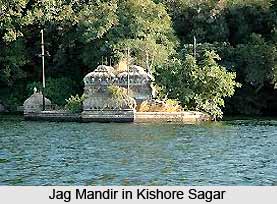 Kota, also known as the industrial capital of north Rajasthan, is the capital of the Kota district. The monuments of Kota, resplendent palaces and forts, exist side by side with modern factories in this quaint little place. Kota lies on the east bank of the Chambal River, below a deep gorge straddling one of the main lateral trade routes from the plains of Delhi to the fertile lowlands of Gujarat. The history of Kota alternated between periods of expansion and contraction, depending on the political environment. In the early 19th century, under the enlightened tutelage of Zalim Singh, Kota weathered the worst political storms and emerged a prosperous and flourishing state. On his death this stability was lost. It was not recovered until 1894, when British intervention reunited the territory.
Kota, also known as the industrial capital of north Rajasthan, is the capital of the Kota district. The monuments of Kota, resplendent palaces and forts, exist side by side with modern factories in this quaint little place. Kota lies on the east bank of the Chambal River, below a deep gorge straddling one of the main lateral trade routes from the plains of Delhi to the fertile lowlands of Gujarat. The history of Kota alternated between periods of expansion and contraction, depending on the political environment. In the early 19th century, under the enlightened tutelage of Zalim Singh, Kota weathered the worst political storms and emerged a prosperous and flourishing state. On his death this stability was lost. It was not recovered until 1894, when British intervention reunited the territory.
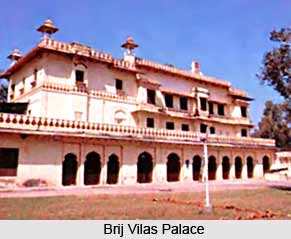 The monuments of Kota comprise a number of resplendent palaces and forts. The City Palace and fort beside the Kota barrage is one of the largest fort complexes in Rajasthan. Built from 1625 onwards, it reflects the turbulent history of the state in that it evolved over a long period, growing in times of stability and stagnating in adversity. There is no large ordered plan found in the construction of the palace. Located here are a Durbar Hall and the Bhim Mahal from the early 18th century. These are covered with Rajput miniatures depicting the history and legends of Kota. The exterior of the palace is a mixture of robust fortification and delicate ornamental stonework. There is some fine ivory and ebony inlay work and a profusion of surface ornament. The entrance to the palace is the Hathi Pol or the Elephant gate. It is flanked by later murals showing a royal wedding procession and bracketed elephants, whose trunks form a triumphal gesture over the central arch.
The monuments of Kota comprise a number of resplendent palaces and forts. The City Palace and fort beside the Kota barrage is one of the largest fort complexes in Rajasthan. Built from 1625 onwards, it reflects the turbulent history of the state in that it evolved over a long period, growing in times of stability and stagnating in adversity. There is no large ordered plan found in the construction of the palace. Located here are a Durbar Hall and the Bhim Mahal from the early 18th century. These are covered with Rajput miniatures depicting the history and legends of Kota. The exterior of the palace is a mixture of robust fortification and delicate ornamental stonework. There is some fine ivory and ebony inlay work and a profusion of surface ornament. The entrance to the palace is the Hathi Pol or the Elephant gate. It is flanked by later murals showing a royal wedding procession and bracketed elephants, whose trunks form a triumphal gesture over the central arch.
The Kota fort is one of the largest fort complexes in Rajasthan. It was built in 1264 and expanded over the years. The rampart of the fort is one of the highest in Rajasthan, with massive bastions, 6 double gates and 25 towers. A number of palaces are found situated inside the fort- Madhao Singh Mahal, Bada Mahal, Raj Mahal, Jhala Haveli and Chhatra Mahal. The main entrance to the fort is via the Naya Darwaza.
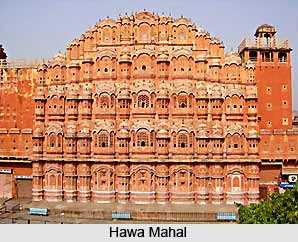 The Akhade Ka Mahal was added to the west of the inner court between 1723 and 1756, and was later enlarged and recast between 1888 and 1940. The prominent Hawa Mahal, added next to the entrance to the fort in 1864, is based loosely on the famous facade at Jaipur. The cenotaphs of the ruling family lie nearby.
The Akhade Ka Mahal was added to the west of the inner court between 1723 and 1756, and was later enlarged and recast between 1888 and 1940. The prominent Hawa Mahal, added next to the entrance to the fort in 1864, is based loosely on the famous facade at Jaipur. The cenotaphs of the ruling family lie nearby.
The Maharao Madhao Singh Museum is situated within the old palace. It houses a fabulous collection of Rajput miniature paintings of the Kota School. Apart from this found herein are exquisite sculptures, frescoes, armoury, antique garments, toys, and a rich collection of items used by the Kings of Kota. To the right is the Raj Mahal. This palace is exquisitely painted and has excellent mirror work.
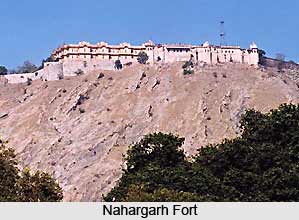 The Umaid Bhawan Palace was built for Umed Singh II in 1904. The construction of the palace was commissioned to Sir Swinton Jacob, a distinguished officer of the British army. It is faced in buff-coloured stone with stucco dressings and incorporates a great deal of scholarly Rajput detail, but the overall composition and much of the interior is European and Edwardian in conception. It might be said that the palace evidences a harmonious blend of Rajput and Victorian architectural styles. There is a fine drawing-room and banqueting hall, picturesque ceiling, marble corridors and a beautiful garden, renowned for its spectacular herbaceous borders. The Palace currently functions as a Luxury hotel.
The Umaid Bhawan Palace was built for Umed Singh II in 1904. The construction of the palace was commissioned to Sir Swinton Jacob, a distinguished officer of the British army. It is faced in buff-coloured stone with stucco dressings and incorporates a great deal of scholarly Rajput detail, but the overall composition and much of the interior is European and Edwardian in conception. It might be said that the palace evidences a harmonious blend of Rajput and Victorian architectural styles. There is a fine drawing-room and banqueting hall, picturesque ceiling, marble corridors and a beautiful garden, renowned for its spectacular herbaceous borders. The Palace currently functions as a Luxury hotel.
The Jagmandir Palace is another popular monument of Kota. It rises picturesquely out of a small island on the artificially constructed Kishore Sagar Lake. The Palace was built in the year 1740 by a Queen of Kota. It is a beautiful red sandstone palace.
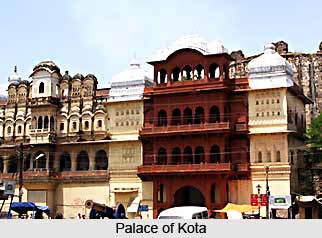 On the North side of the Kishor Sagar Lake is the Brij Vilas Palace Museum. It exhibits an interesting collection of weapons, statues and paintings. A rare collection of coins and Sanskrit manuscripts are found here.
On the North side of the Kishor Sagar Lake is the Brij Vilas Palace Museum. It exhibits an interesting collection of weapons, statues and paintings. A rare collection of coins and Sanskrit manuscripts are found here.
Featuring among the other impressive monuments in Kota is the Haveli of Devtaji. The Haveli is famous for its beautiful paintings and frescoes. Other ancient monuments which can be visited from Kota are the Nahargarh fort and the temple complex of Badoli. The latter is situated 56 kms to the South West of Kota. The temples contained here are some of the oldest in Rajasthan, dating as far back as the ninth century.
The Bhanddeora temple is situated at a distance of 110 km from Kota. Also known as the "Khajuraho of Rajasthan", this temple is an important religious site of Kota. The temple is believed to have been built sometime between 11th and 12th century.
There are also some other buildings of note in Kota. These include General Hospital, Hospital for Women, the Crosthwaite Institute, the Curzon Wyllic Memorial, the Herbert High School and the Girls` School.
Kota is now a fast growing industrial station, complete with an atomic power station and a river barrage. However, the ancient monuments of Kota existing side-by-side with modern technology still lend it on old world charm.



















